 Food scientist and author Edward Elmer “Doc” Smith, often called “the father of space opera,” was born 125 years ago, on May 2, 1890. His first published work, “The Skylark of Space,” was written with the help of a neighbor, Mrs. Lee Hawkins Garby.
Food scientist and author Edward Elmer “Doc” Smith, often called “the father of space opera,” was born 125 years ago, on May 2, 1890. His first published work, “The Skylark of Space,” was written with the help of a neighbor, Mrs. Lee Hawkins Garby.
Smith began writing the first Skylark yarn in 1915, taking five-plus years to complete the work. At the time, there was no model for Smith’s tale. A grand story spanning across galaxies, it was serialized by Hugo Gernsback, beginning in the August 1928 issue of AMAZING STORIES. Also appearing in that same issue was Philip Nowlan’s “Armageddon – 2419 A.D.,” the story that introduced Buck Rogers to the reading public.
Smith would go on to write two more Skylark stories for the pulps and a third, “Skylark DuQuesne,” that was originally serialized in the digest magazine IF: WORLDS OF SCIENCE FICTION, beginning in June 1965.
Although the Skylark stories served to introduce readers to space opera, it was Doc’s Lensman stories that truly defined the sub-genre. Consisting of seven novels published over a fourteen-year span, the series also began in AMAZING STORIES. “Triplanetary” started in the January 1934 issue and ran through the April number. Although the Lensman stories appeared in a number of books and pulp magazines, it is the final four novels of the series that truly define Smith’s great saga. Originally published in Street & Smith’s ASTOUNDING between September 1937 and February 1948, these novels owe a great deal to John W. Campbell, the magazine’s editor beginning in 1938.
Smith would publish other works of science fiction, including “Spacehounds of IPC,” “Lord Tedric,” and “Subspace Survivors,” but none would approach the scope of the Skylark tales and, even more so, the Lensman yarns.
E. E. “Doc” Smith, the food scientist who specialized in doughnut mixes and science-fiction, died on the last day of August in 1965. One-hundred twenty-five years old today, Smith’s work inspired a host of authors to fill the pages of AMAZING STORIES, PLANET STORIES, and other magazines and media with tales of action and adventure, some of them even set “a long ago in a galaxy far, far away . . . ”
(Frank R. Paul’s cover for the August 1928 issue of AMAZING STORIES, in which the first Skylark story appeared, is one of the most iconic images from the science-fiction pulps.)







